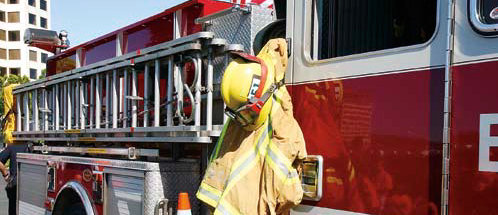 10
Facts you should know about
10
Facts you should know about
fire monitoring services
Fact
 The
Standard is referenced in the National Building Code and
National Fire Code
The
Standard is referenced in the National Building Code and
National Fire Code The National Building Code and the National Fire Code requires that a fire signal receiving center and a fire protective signaling system at a protected property meet the requirements of CAN/ULC-S561, Installation and Services for
Fire Signal Receiving Centres and Systems.
In addition, the Standard for the installation of fire alarm systems –CAN/ULC-S524-06, Installation of Fire Alarm Systems – requires that the interconnection
between a fire alarm system control unit and a fire signal receiving center comply with the same CAN/ULCS561. These two Standards are not only separately referenced in the Code, but are integral to each other in that conformance to CAN/ULC-S561 is directly linked to CAN/ULC-S524.
Fact
 The
Standard covers more than signaling
The
Standard covers more than signaling In addition to signaling, the CAN/ULCS561 Standard requires that fire signal receiving centers conform to specifics such as ratings of fire separations, exiting, and other construction and safety requirements as well as operating procedures, standby/back-up systems, signal receivers, automation systems, emergency lighting and basic fire protection.
Fact
 Trained
staff and installation/ servicing requirements
Trained
staff and installation/ servicing requirementsThe Standard defines the requirements for trained staff that handle operation of a fire signal receiving station. It also covers
the installation and service of a fire protective signaling system at a protected property. It should be noted that subcontracting is not permitted under
the ULC system certificate program.
Fact
 Signal
transmitting and receiving units must meet standards
Signal
transmitting and receiving units must meet standardsThe signal transmitting unit located at a monitored premises and signal receiving units located at a fire signal receiving center are required to comply with the requirements of CAN/ULC-S559, Equipment for Fire Signal Receiving Centres and Systems, or CAN/ULC-S527, Standard for Control Units for Fire Alarm System. Equipment and devices not Listed by a nationally accredited certification
body such as ULC do not meet the intent of the National Building Code.
Fact
 Communications
path systems are defined Communication can come in the form of
passive or active communication.
Communications
path systems are defined Communication can come in the form of
passive or active communication.Examples of passive systems are dual path systems and cellular back up; an example of an active system is Internet Protocol (IP). Transmitting and receiving equipment are ULC Listed to work with both types of communication channels and is tested to determine if there is telephone line supervision between a protected property and a fire signal receiving center.
Fact
 Two
Systems for Fire protection signaling systems
Two
Systems for Fire protection signaling systemsIt is sometimes assumed fire protection systems apply to only monitoring fire alarms. In fact, fire protective signaling systems are categorized in two separate systems:
• Fire alarm panel monitoring
• Standalone sprinkler alarm monitoring
Fact
 What
constitutes a compliant system
What
constitutes a compliant systemFor a system to be considered compliant, it has to include a Listed, i.e., tested and certified by a nationally accredited certification body, signal transmitting unit utilizing an approved communication path transmitting signals to a Listed fire signal receiving center. Supervision is required from the connections in a fire alarm system control unit to a fire alarm transmitter communicating on an approved communication path (passive or active) through to a Listed fire signal
Fact
 Clarity
on the disposition of signals
Clarity
on the disposition of signals• Fire alarm signals to be transmitted to a fire signal receiving center within 60 seconds
• Fire signal receiving center personnel must contact the fire department within 30 seconds Defining the transmission time provides much more clarity for code users compared to previous requirements.
Fact
 Clearly
defined periodic testing
Clearly
defined periodic testingAll fire protective signaling systems are required to be tested annually with records documenting the testing. These tests are required by CAN/ULC-S561 and are in addition to those required by CAN/ULC-S536, Standard for the Inspection and Testing of Fire Alarm Systems. Stand-alone sprinkler risers shall be tested bimonthly. For these systems to remain working at all times, regular maintenance and testing at a protected property is needed.
Fact
 The
assurance of a ULC certificate
The
assurance of a ULC certificate Once the installer of the fire protective signaling system determines that fire protective signaling system has been installed in accordance with requirements of CAN/ULC-S561 the installer would then request a ULC Certificate for the protected property, ULC issues a ULC certificate and this is displayed at a fire alarm monitoring panel. The certificate states that an installation, equipment and method of communication adhere to applicable ULC Standards. This certificate is the only proof that a building is being monitored in accordance with applicable ULC Standards.
Summary
In summary, a ULC protective signaling services
certificate provides a code authority the necessary evidence
that a complete system complies with the CAN/ULC-S561
Standard.
*Excerpt from UL The Standard in Safety -The Fire & Security Authority 2010 Issue 2
*Excerpt from UL The Standard in Safety -The Fire & Security Authority 2010 Issue 2